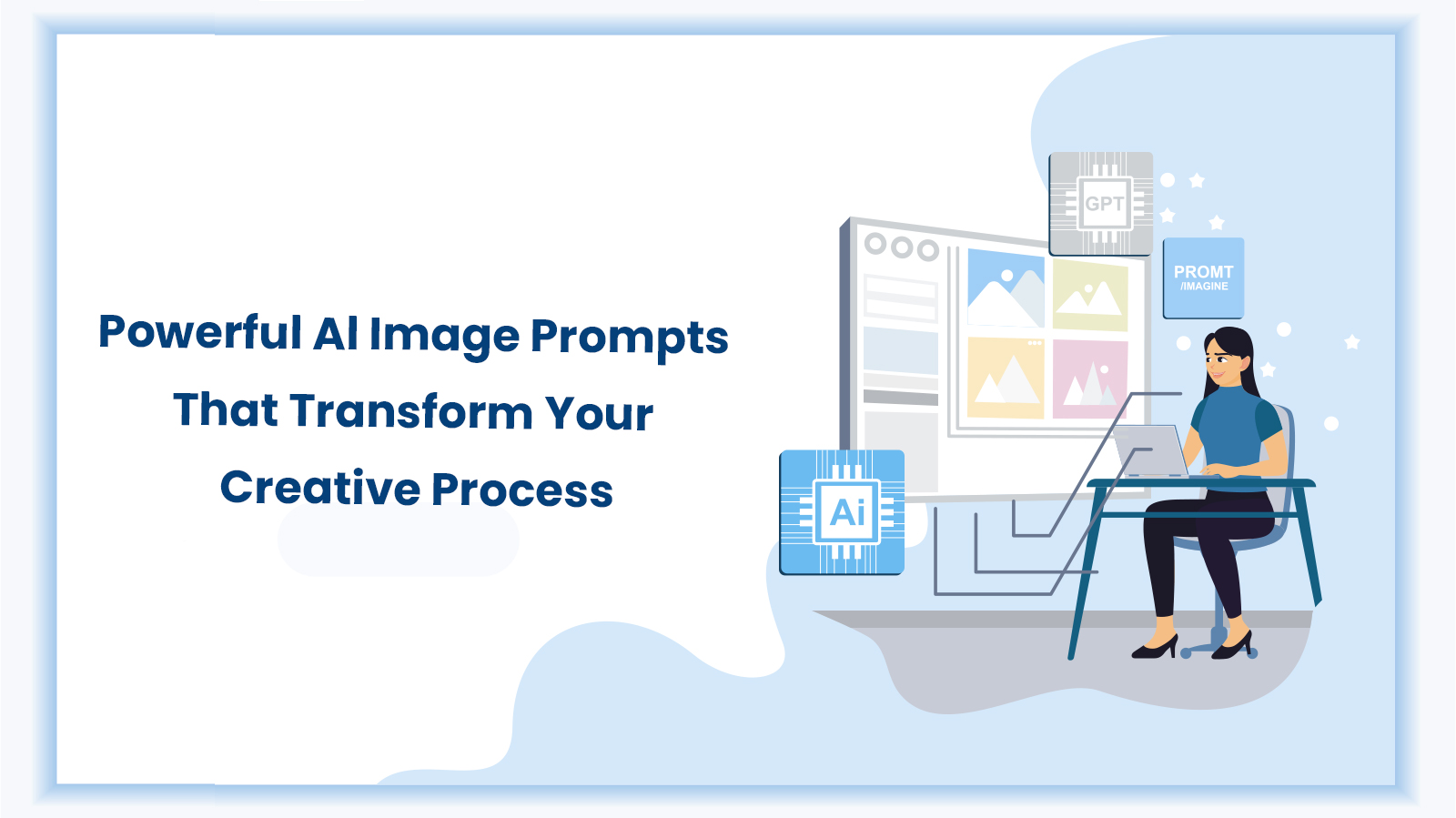AI image generation is revolutionizing how we create visual content today. This guide explores AI image prompts that help you generate stunning visuals for digital marketing, social media, and blog content. You’ll discover practical techniques, real examples, and expert strategies to master AI image generation tools such as ChatGPT and Gemini.
Whether you’re a marketer, blogger, or creative professional, these AI image prompts will transform your visual content creation process. We’ll cover everything from basic prompt structure to advanced techniques that produce professional-quality images.
What Are AI Image Prompts?
AI image prompts are text instructions you give to artificial intelligence tools to generate specific images. These prompts act as blueprints that guide AI systems in creating visual content based on your descriptions.
Think of AI image prompts as recipes for visual creation. Just like cooking recipes need specific ingredients and instructions, AI image generation requires detailed prompts to produce desired results.
The quality of your AI image prompts directly affects the output quality. Better prompts create more accurate, visually appealing, and relevant images for your projects.
How AI Image Generation Works
AI image generation uses machine learning models trained on millions of images and text descriptions. These models learn patterns between words and visual elements.
When you input an AI image prompt, the system analyzes your text and generates pixels that match your description. The process happens in seconds, creating unique images based on your specifications.
Modern AI image generation tools understand context, style preferences, and technical requirements. They can produce everything from photorealistic portraits to abstract art designs.
Types of AI Image Prompts
Descriptive Prompts
Descriptive AI image prompts focus on detailed visual descriptions. These prompts work best for creating specific scenes or objects.
Structure: Subject + Setting + Style + Details
Example for Digital Ads:
“Create a 9:16 vertical high-resolution educational poster. Place a large 3D capsule in the center of the composition. The top half of the capsule should be glossy red and display the ‘DG Institution Training & Development’ logo (uploaded) prominently like a printed brand mark. The bottom half of the capsule should be transparent, revealing a large number of vibrant, stylized course cards stacked or floating inside.
Each course card should include labels and small icons representing a variety of training topics such as:
- Prompt Engineering
- PPT Mastery
- Canva Editing
- ChatGPT
- Video Editing
- English Speaking
- Digital Marketing
- Microsoft Excel
- DALL·E or Midjourney Basics
The background should be a clean light yellow or soft modern gradient, with a professional aesthetic. Make the capsule appear realistic and futuristic with a glossy finish and a soft shadow. The overall style should be sleek, visually appealing, and suited for an online educational promotion.”
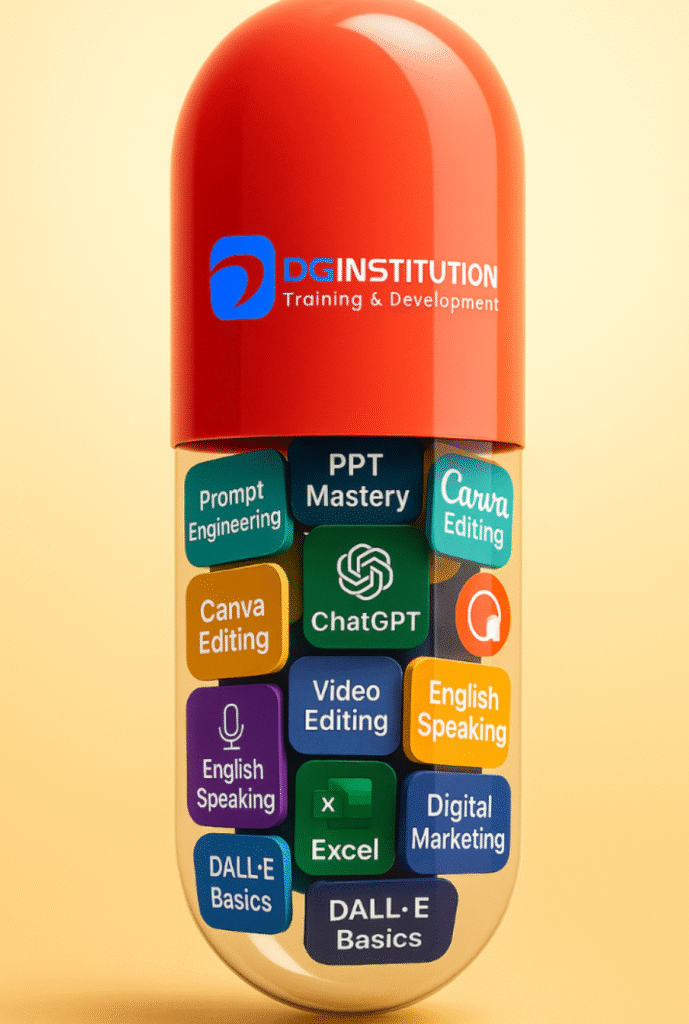
Style-Based Prompts
Style-based AI image prompts emphasize artistic techniques or visual aesthetics. These prompts help maintain brand consistency across your visual content.
Example for Social Media:
Create an image where four hikers in stylish outdoor gear are pushing a sleek wooden cart carrying a glowing DG Institution logo that is attached up a lush, green hilltop trail. The sun sets behind the mountains, casting golden light over the landscape. The logo radiates subtly, symbolizing knowledge and progress.
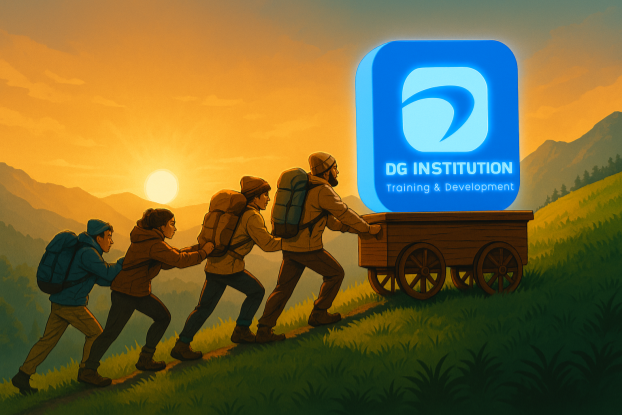
Mood and Emotion Prompts
These AI image prompts capture specific feelings or atmospheres in your visuals. They work excellently for brand storytelling and emotional marketing.
Example for Blog Content:
Create an image where A group of imaginative children dressed as tiny chefs joyfully mess around with icing and sprinkles, somehow ending up crafting a playful cake that transforms into our logo — the mood is full of innocence, wonder, and surprise.

Technical Specification Prompts
Technical AI image prompts include specific requirements for resolution, format, and technical details. Use these for professional projects with exact specifications.
Example for Digital Marketing:
Generate my logo icon using these commands
{ “icon_style”: { “perspective”: “isometric slight tilt-up”, “geometry”: { “proportions”: “1:1 ratio canvas with generous negative space”, “element_arrangement”: “logo central, ascending lines or steps behind” }, “composition”: { “element_count”: “3 main objects: logo, upward lines/steps, a symbolic horizon”, “spatial_depth”: “layered using a foreground logo, midground pathway, background light burst”, “scale_consistency”: “logo is dominant, other objects support scale” }, “lighting”: { “type”: “soft ambient with motivational glow”, “light_source”: “rear-top-right, warm tones”, “shadow”: “soft shadow under logo and steps”, “highlighting”: “subtle edges to create uplifting effect” }, “textures”: { “material_finish”: “smooth semi-gloss, like brushed metal”, “surface_treatment”: “sleek, modern detailing with faint texture”, “texture_realism”: “stylized realism, avoiding harsh details” }, “render_quality”: { “resolution”: “ultra-HD vector or octane 3D”, “edge_definition”: “crisp without outlines, use lighting contrast”, “visual_clarity”: “bold shapes, well-defined margins” }, “color_palette”: { “tone”: “corporate modern: cool blues and silver-gray with energy yellow”, “range”: “2–3 harmonious tones, calm yet motivational”, “usage”: “primary logo blue dominant, accents in light and shadows” }, “background”: { “color”: “#F9FAFC”, “style”: “gradient sky wash, light horizon fade”, “texture”: “none” }, “stylistic_tone”: “inspiring, optimistic, professional growth”, “icon_behavior”: { “branding_alignment”: “perfect for upward-skill messaging”, “scalability”: “clear at all sizes”, “interchangeability”: “works with other growth-related scenes” } } }

Advanced AI Image Prompt Techniques
Layered Prompting
Layered AI image prompts combine multiple elements for complex visuals. Start with the main subject, add environment details, then specify style and technical requirements.
This technique produces more sophisticated and detailed images that meet professional standards.
Negative Prompts
Negative prompts tell the AI what NOT to include in your image. These AI image prompts help avoid unwanted elements and improve output quality.
Example:
Avoid: distorted or unclear DG Institution logo, unreadable or blurry course cards, irrelevant icons or topics (e.g., cooking, gaming, fashion), cluttered or messy composition, dark or dull lighting, incorrect text fonts, poorly aligned graphics, low-resolution image quality, unrelated branding elements, coffee spills, paper textures, pixelated edges, outdated UI elements, overly cartoonish styles, human figures, exaggerated facial expressions, cluttered background, chaotic color schemes, excessive shadows, poor contrast, broken symmetry, incorrect proportions of the cup or cards, typography that doesn’t match the DG brand, misplacement of logo (e.g., upside down or off-center), and missing theme of training and development.
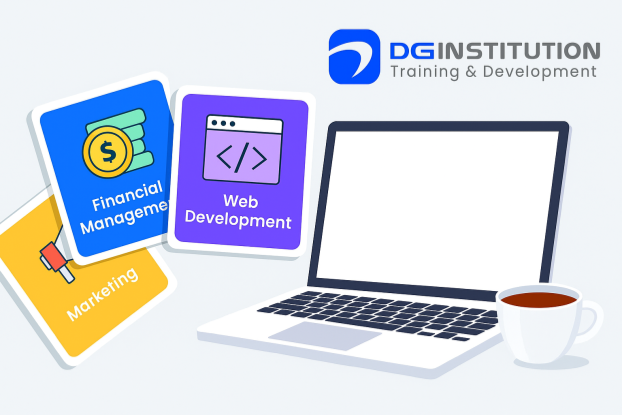
Prompt Weighting
Some AI image generation tools allow weighting different parts of your prompt. This technique emphasizes important elements while de-emphasizing others.
AI Image Prompts for Different Industries
Digital Advertising
Fast-moving, attention-grabbing images are essential for digital advertising. Strong visual hierarchy, bold colors, and unambiguous messaging should be the main features of your AI image prompts.
Sample Prompt:
Create a 3D hyper-realistic scene of a giant café cup resembling a cozy training center labeled ‘DG Training Land’. The cup is filled with colorful 3D icons: books, certificates, gears, and digital tools. Around the cup, miniature construction workers in yellow safety gear are installing signs, painting icons, setting bricks, and adding details. Include a friendly rounded sans-serif logo on the cup. Warm café colors: espresso brown, vibrant orange, and smart blue. Soft lighting, warm tones, realistic shadows. Ideal for digital ads and web banners.
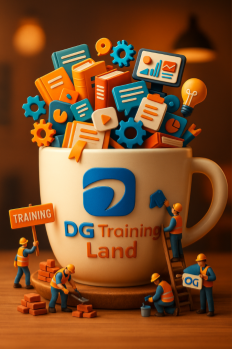
Social Media Content
Social media AI image prompts should consider platform specifications and audience preferences. Focus on trending styles and engaging visual elements.
Sample Prompt:
Create a hyper-realistic 3D cinematic image of a miniature construction site where tiny workers in yellow helmets and uniforms are assembling a massive ‘AI Course’ sign on a futuristic tech-themed platform. The workers are using cranes, ladders, and blueprints, with the uploaded DG Training Land logo being mounted like a steel beam. Use realistic lighting, shallow depth of field, and dramatic cinematic angles. Background: a dusty construction zone with tech-inspired scaffolding. Ideal for Instagram Reels or carousel.
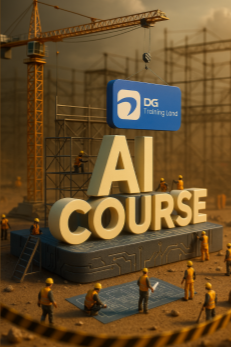
Blog Illustrations
Supporting and illustrative images enhance blog content. Your AI image prompts should improve reader comprehension and go well with your written content.
Sample Prompt:
Create a 3D hyper-realistic visual illustrating the concept of teamwork and collaboration. The scene should depict a diverse group of professionals (different ethnicities, genders, and roles) gathered around a sleek, modern conference table in a contemporary office setting. They are engaged in an active, collaborative discussion, with laptops, notepads, coffee mugs, and digital tablets in front of them. In the center of the glass-top table, project a holographic logo of “DG Institution” (rounded sans-serif style) glowing subtly, as if it’s emerging like a guiding light. Use warm, professional lighting with realistic shadows to enhance depth and atmosphere. Emphasize natural human interaction, focused expressions, and gesture-driven communication. The visual should be in horizontal (landscape) format, suitable for blog headers or feature illustrations. Color palette: smart blues, espresso brown, soft white, and metallic accents. Photography-style realism with a futuristic, yet professional corporate tone.

Common AI Image Prompt Mistakes
Vague Descriptions
Results from vague AI image prompts are not always consistent. Your prompts should always contain precise information about the subjects, settings, colors, and styles.
Overcomplicating Prompts
The AI system is frequently confused by complex AI image prompts that contain an excessive number of elements. For better results, make sure your prompts are well-structured and focused.
Ignoring Technical Requirements
Images that are not appropriate for your intended use may result from failing to specify technical requirements such as resolution, format, or aspect ratio.
Not Testing Variations
Your creative options are limited when you use the same AI image prompts over and over. Try a variety of approaches and wordings to get a range of results.
Optimizing Your AI Image Prompts
Research Keywords
Research relevant keywords for your industry and incorporate them into your AI image prompts. This approach helps generate more targeted and relevant visuals.
Study Successful Examples
Analyze successful AI-generated images in your field. Study their prompt structures and adapt similar techniques for your projects.
Iterate and Refine
Refining your AI image prompts through multiple iterations improves results. Save successful prompt formulas for future use.
Keep Prompt Libraries
Maintain organized libraries of effective AI image prompts for different purposes. This practice saves time and ensures consistent quality.
AI Image Generation Tools Comparison
Tool | Strengths | Best For | Prompt Style |
ChatGPT DALL-E | Natural language processing | Conceptual images | Conversational prompts |
Gemini | Context understanding | Complex scenes | Detailed descriptions |
Midjourney | Artistic quality | Creative projects | Style-focused prompts |
Stable Diffusion | Customization | Technical control | Parameter-rich prompts |
Perplexity | Real-time search & citations | Research & current information | Question-based prompts |
Future of AI Image Generation
AI image generation continues evolving rapidly. New models produce increasingly realistic and diverse outputs from simple AI image prompts.
Future developments will likely include better context understanding, improved style consistency, and more intuitive prompt interfaces.
DG Training Land recognizes this growing field and will soon offer comprehensive AI courses covering advanced AI image generation techniques. These courses will help professionals master the latest tools and prompt strategies for various industries.
Learn how to use AI image prompts now to stay ahead of the curve. In every industry, there is an increasing need for creative professionals who understand AI.
Conclusion
Gaining proficiency with AI image prompts allows you to create visual content with virtually limitless creative possibilities. Professionals’ approaches to design, marketing, and visual storytelling – skills that are becoming more and more important in both personal and professional contexts are being revolutionized by these potent tools.
In fact, companies are starting to incorporate prompt engineering and AI image generation into their corporate training programs in an effort to future-proof their workforce. Our Corporate Training Courses in Dubai provide professionals with hands-on learning experiences designed to boost productivity and creative output through AI tools.
Start experimenting with the prompt examples provided in this guide. As you refine your prompts, you’ll see real improvements in quality and output.
The future belongs to creators who combine human creativity with artificial intelligence.
Sign up now for our AI Courses in Dubai and start designing like a pro!
AI tools are powerful, but classic design software like Photoshop still plays an important role. Explore the top benefits of using Adobe Photoshop for your creative projects.
FAQs
A good AI image prompt should be between 20 and 100 words long. Focus on essential details rather than prompt length.
AI tools can generate images similar to copyrighted material. Always ensure your prompts create original content for commercial use.
Different tools excel in different areas. ChatGPT DALL-E works well for conceptual images, while Gemini handles complex scenes effectively.
Practice regularly, study successful examples, and experiment with different prompt structures. Join AI communities for tips and feedback.
Professional photography is not replaced by AI image generation; rather, it enhances it. It’s excellent for concept work and quick iterations.
Current limitations include difficulty with specific faces, text within images, and highly complex scenes. Technology continues improving rapidly.
Develop standardized prompt templates that include your brand colors, style preferences, and visual guidelines.

